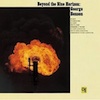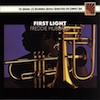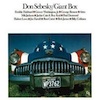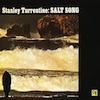
Celebrating CTI Records’ 40th Anniversary – Part 3
Contributed by guest blogger Doug Payne (Sound Insights)
Masterworks Jazz continues the 40th anniversary celebration of the legendary CTI Records legacy that began last October with an additional four titles issued this week: George Benson’s Beyond the Blue Horizon, Freddie Hubbard’s First Light, Don Sebesky’s all-star Giant Box and Stanley Turrentine’s Salt Song. While each of the releases have had previous American CD issues, most have been out of print for a number of years and each are important – and significant – milestones in the CTI tradition.
 Beyond the Blue Horizon – George Benson: Guitarist George Benson had already waxed three records for Creed Taylor, including the iconic The Other Side of Abbey Road, a jazz take on the famed album by The Beatles’, and made significant contributions to such early CTI classics as Stanley Turrentine’s Sugar and Freddie Hubbard’s Straight Life when he recorded Beyond the Blue Horizon, the guitarist’s first CTI album, in February 1971.
Beyond the Blue Horizon – George Benson: Guitarist George Benson had already waxed three records for Creed Taylor, including the iconic The Other Side of Abbey Road, a jazz take on the famed album by The Beatles’, and made significant contributions to such early CTI classics as Stanley Turrentine’s Sugar and Freddie Hubbard’s Straight Life when he recorded Beyond the Blue Horizon, the guitarist’s first CTI album, in February 1971.
It is not only one of the guitarist’s most full-bodied jazz records – before or since – it is also probably the single best document of Benson’s technically fluid facility and his musically inventive lyricism at any tempo. Supporting the guitarist in this endeavor are fellow CTI all-stars Ron Carter on bass and Jack DeJohnette on drums. Of curious note here, however, is the addition of Clarence Palmer, on organ.
But any thought that Beyond the Blue Horizon is some organ combo grinding out some forgettable soul jazz is quickly allayed by the fantastically vibrant take on Miles Davis’ “So What,” which opens the album. It’s so audibly logical and rhythmically sensible that it’s hard to believe the song wasn’t written this way in the first place. Luiz Bonfá’s lovely “The Gentle Rain” follows in a heavily percussive timbre that elicits one of Benson’s more angular and metallic commentaries, suggesting something more of a gathering storm. Benson seems to be providing an electric counterpoint here to Bonfá’s acoustic original.
The remainder of the album is taken up by the presence of three (!) strong Benson originals, “All Clear,” “Ode to a Kudu” and “Somewhere in the East.” All three offer some of Benson’s most beautiful playing and Carter and DeJohnette’s deftly sensitive support.
Beyond the Blue Horizon’s cover features Pete Turner’s dramatic “Flames,” shot in 1964 in Libya as part of a series the photographer produced for Standard Oil. The photo’s iconography perfectly captures Benson’s fiery and hypnotically transfixing performance throughout the record.
 First Light -Freddie Hubbard: Trumpeter Freddie Hubbard’s third CTI album was issued in January 1972 to sparse critical fanfare. The little critical attention the album did receive was mostly negative, particularly from the jazz cognoscenti, who saw Hubbard’s step onto this slippery slope of pop super-stardom start with his previous CTI albums. First Light was the last straw. Freddie Hubbard’s reputation with jazz critics never really recovered.
First Light -Freddie Hubbard: Trumpeter Freddie Hubbard’s third CTI album was issued in January 1972 to sparse critical fanfare. The little critical attention the album did receive was mostly negative, particularly from the jazz cognoscenti, who saw Hubbard’s step onto this slippery slope of pop super-stardom start with his previous CTI albums. First Light was the last straw. Freddie Hubbard’s reputation with jazz critics never really recovered.
Despite the presence of some of jazz’s best – and most influential – artists, including guitarist George Benson, pianist Richard Wyands, bassist Ron Carter and drummer Jack DeJohnette, First Light was slammed for Don Sebesky’s always critically-attacked sweetening and the presence of a huge pop-hit cover of the day (the million-selling number 1 hit “Uncle Albert Admiral Halsey” by Paul and Linda McCartney).
Even Hubbard’s superb title song was derided as a riff-based jam tune that didn’t require the chops or the talent of a soloist who factored on some of the era’s most important jazz recordings by otherwise-celebrated jazz heroes Oliver Nelson, John Coltrane, Eric Dolphy, Ornette Coleman and Herbie Hancock. Still, First Light proved not only to be one of CTI’s very best sellers at the time, it also won the trumpeter his first and only Grammy Award in 1972 for Best Jazz Performance over and above other such CTI competition as George Benson’s White Rabbit (also arranged by Don Sebesky) and Joe Farrell’s Outback. The trumpeter himself was often heard to claim First Light as his personal favorite of his own records.
Hubbard’s title track is a truly inspired composition that seemingly yields more than its 11 minutes suggests. Freddie Hubbard wails with impassioned desire. George Benson plays one of his most deliciously intricate, yet achingly lyrical solos. Carter comps (if that doesn’t sound too derogatory) in a way that suggests melody and counter-melody all at once. Sebesky lays back quite a bit, only adding spare commentary from properly placed strings, vibes (playing accentuating whole tones, a Sebesky trait) and a flute section led by Hubert Laws, who solos occasionally. “First Light” became something of a hit (it was issued as the album’s single) and a signature song for the trumpeter.
Like so many of Don Sebesky’s previous Beatles arrangements, “Uncle Albert/Admiral Halsey” is a lot better than it sounds like it would be. It’s more imaginative than listeners of the McCartneys’ song would expect, matching a Stravinsky-styled arrangement with a funk rhythm which makes for creative jazz and provides sparklingly terrific solos from Hubbard, Benson, Carter and Laws. “Moment to Moment,” Henry Mancini’s surprisingly little-known theme from the 1965 film of the same name, and Leonard Bernstein’s “Lonely Town” (from On the Town) both get terrifically orchestral readings here that focus purely on Freddie’s melodicism and Sebesky’s impressionistic backdrop. Sebesky’s “Yesterday’s Dreams” is absolutely ravishing as Hubbard mutes his horn.
Like Hubbard’s previous album, Straight Life, First Light benefits by not one but two Pete Turner photographs, one on the front cover and a different one on the back cover. The front cover, one of the few CTI releases of the period that actually showed the artist, was especially shot for the album to show Hubbard and his horns. The back cover photo, “Hong Kong Rolls” (1963), was juxtaposed by the photographer himself to reflect the front cover’s golden horns, presumably both reflecting the golden glow of “first light.”
 Giant Box – Don Sebesky: Don Sebesky had been arranging albums for producer Creed Taylor since the composer/arranger got a call from the producer out of the clear blue sky in 1965. It’s little wonder that Creed Taylor invited Don Sebesky to CTI in 1970 to become the in-house arranger for some of the label’s premier recording artists, almost single-handedly setting the musical direction for the label on such albums by Hubert Laws, George Benson, Freddie Hubbard, Hank Crawford, Esther Phillips, Jackie & Roy, Milt Jackson and Airto.
Giant Box – Don Sebesky: Don Sebesky had been arranging albums for producer Creed Taylor since the composer/arranger got a call from the producer out of the clear blue sky in 1965. It’s little wonder that Creed Taylor invited Don Sebesky to CTI in 1970 to become the in-house arranger for some of the label’s premier recording artists, almost single-handedly setting the musical direction for the label on such albums by Hubert Laws, George Benson, Freddie Hubbard, Hank Crawford, Esther Phillips, Jackie & Roy, Milt Jackson and Airto.
Following CTI’s success of Deodato’s “Also Sprach Zarathustra (2001),” the producer offered Sebesky the opportunity to do a double album – the very first (and only one of three) in CTI’s history – and the arranger quickly took up the challenge. Giant Box, originally issued in real box packaging, like so many classical records of the day, not only felt significant, it contained a heavy roster of the day’s biggest and best jazz players, all part of the CTI family and all reflecting on a program of Sebesky charts that make for some of the label’s most potent listening.
First and foremost is the extraordinarily inspired pairing of Stravinsky’s “Firebird” with the Mahavishnu Orchestra’s “Birds of Fire,” remarkably balancing horns and strings and features for Hubert Laws, Freddie Hubbard, Don Sebesky and Billy Cobham. Joni Mitchell’s lovely “Song to a Seagull,” originally from her 1968 debut, is a soaring feature here for Paul Desmond, Don Sebesky and Ron Carter. Sebesky’s dynamic “Free as a Bird” is one of the album’s highlights and is a feature for Freddie Hubbard’s jaunty flugelhorn, Bob James’ fantastically sparkling piano, Sebesky’s scintillating electric-piano commentary, Grover Washington, Jr.’s meaty soprano sax and the rhythmic interactions of Ron Carter and, of course, Jack DeJohnette.
Jimmy Webb’s “Psalm 150,” marvelously highlights the vocal talents of Jackie & Roy (and Sebesky himself) in a sumptuously funked-out arrangement that features Freddie Hubbard, Ron Carter and Bob James (on organ!). Rachmaninoff’s 1912 piece “Vocalise” gets a melodic treatment here – but surprisingly no vocals – with leads provided by alto saxist Paul Desmond and vibist Milt Jackson, who’d previously been paired together for the first time at a December 1971 Modern Jazz Quartet concert.
Sebesky’s own “Fly” leads off with a vocal by the composer himself, performing very much like Chet Baker (who he would go onto work with very shortly hereafter), and lifted bodily by echoplexed flourishes from Hubert Laws, Joe Farrell, Ron Carter and Jack DeJohnette that lead into the lovely jazz of “Circles,” another of the album’s greatest moments, featuring Joe Farrell on soprano sax, Bob James (beautiful again) on piano, Ron Carter (again – the bassist single-handedly guides much of the album into beautiful territories much of the time) and Hubert Laws on flute.
The obligatory funk tune, “Semi-Tough,” which was surprisingly never exploited for its radio potential, is aided by Sebesky’s Gospel piano and clavinet, Carter’s ultra-funky electric bass and Billy Cobham’s grooviest groove, and closes out the album with George Benson’s fun but surprisingly undistinguished modified electric guitar solo, Grover Washington, Jr.’s tough tenor and Bob James providing some funky organ. It’s at this point that the absence of Esther Phillips becomes notably apparent. But she’s not missed.
According to Didier Deutsch’s interview with Don Sebesky, the recording took six months and about 150 hours in the studio, though only several days of recording in April 1973 are listed in the credits as being the recording time. Sebesky’s recollection is probably more accurate. There was obviously a lot of work that went into this record. And it’s truly surprising that it’s not a better known part of CTI’s legacy than it is. This beautifully remastered CD release should finally change all that, giving Giant Box the place it deserves.
Pete Turner’s garish cover photo, “USA Car,” is part of an Americana series the photographer conceived that includes photos found on the covers of Ron Carter’s Blues Farm (CTI 6027) and the all-star In Concert Volume Two (CTI 6049). “USA Car,” photographed in Nevada in 1970, oddly seems to contradict the gravity of the project and the classy music found within but designer Bob Ciano probably picked up on the car’s stars for this “all-star” album.
 Salt Song – Stanley Turrentine: This 1971 recording is the second of four CTI albums issued under tenor sax great Stanley Turrentine’s name. Billboard aptly summarized this album in its original, albeit brief review of November 1971 when it said “Stanley Turrentine, one of the most exciting tenor saxophonists to emerge in the 1960s comes up with what will prove to be his biggest albums (sic) to date. The title song and ‘I Told Jesus’ offer good programming potential. Great production job.” Absolutely.
Salt Song – Stanley Turrentine: This 1971 recording is the second of four CTI albums issued under tenor sax great Stanley Turrentine’s name. Billboard aptly summarized this album in its original, albeit brief review of November 1971 when it said “Stanley Turrentine, one of the most exciting tenor saxophonists to emerge in the 1960s comes up with what will prove to be his biggest albums (sic) to date. The title song and ‘I Told Jesus’ offer good programming potential. Great production job.” Absolutely.
When he waxed Sugar for CTI in 1970, Stanley Turrentine created not only one of his most memorable recordings – and a theme song that gave the saxist one of his two beloved nicknames – but one of the label’s best-known and most loved recordings. Sugar was surely a tough act to follow. But Salt Song more than compensates.
Opening with Freddie Hubbard’s bracing “Gibraltar,” Salt Song makes a case for one of Stanley Turrentine’s strongest jazz efforts of the 1970s. The opening song was originally composed by Hubbard for Turrentine’s album Sugar several months earlier. For whatever reason, the song – recorded with Hubbard and often performed by the saxophonist with the trumpeter during this period – was left off of Turrentine’s CTI debut. The Deodato-arranged “I Told Jesus” is one of CTI’s classic gospel blues, offering up especially inspired solos by Turrentine and Gale as well as remarkably simpatico support from bassist Ron Carter, organist Richard Tee and a briefly heard Gospel choir.
The album’s lovely and lilting title song, also known as “Cançao Do Sol,” comes from a performance featured on Milton Nascimento’s Creed Taylor-produced debut Courage (1969). “I Haven’t Got Anything Better To Do” comes from the little-known 1967 Sandra Dee film Doctor, You’ve Got To Be Kidding!. Its first notable jazz performance came from Carmen McRae on Atlantic in 1967. Here, Turrentine provides a sumptuous performance of the charming ballad, aided by Carter’s emotive bass work and Deodato’s pitch-perfect string accompaniment.
Turrentine’s own samba “Storm” wraps up the original album with a cleverness that is as sensual as it is soulful and as dedicated as it is delicious. Guided by Gale’s guitar, which is heard in a typically marvelous solo, Turrentine glides over Carter’s bass and Billy Cobham’s terrifically rhythmic interchange, “Storm” is one of Turrentine’s patented gems, little known but much loved from beginning to end.
This album also features one of my favorite Pete Turner photos, “The Old Man and The Sea,” taken just before a storm (another title the album references) in Portugal in 1966.
Links:
George Benson – Beyond The Blue Horizon
Freddie Hubbard – First Light
Don Sebesky – Giant Box
Stanley Turrentine – Salt Song